Existing User Log In
New User Registration
Register for a free account to gain full access to the VGChartz Network and join our thriving community.



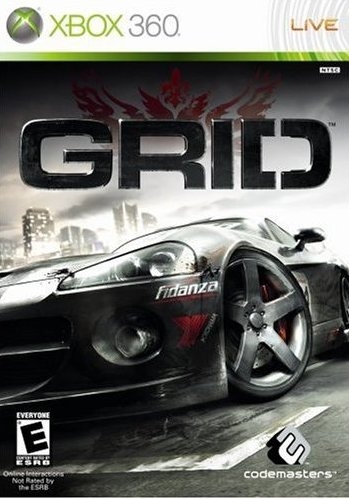

America - Front


America - Back

Race Driver: GRID is brought to us by the experienced racing developer Codemasters. Codemasters’ first racer of this generation came in the form of Colin McRae: DiRT. On the whole DiRT was a solid racer, with some great graphics, a wide variety of racing types, accessible handling and great loading screens, but it did fall short in a couple of respects, most notably with its mediocre online play and some racing types that lacked enjoyment. GRID perhaps has more in common with Codemasters’ TOCA series, but it also doubles-up as a spiritual successor to DiRT - enhancements have been made to the graphics engine, and the damage physics and damage modelling have both been vastly improved, the handling between different car classes is now much more distinguishable, and online play is the best I’ve ever experienced in a racer.
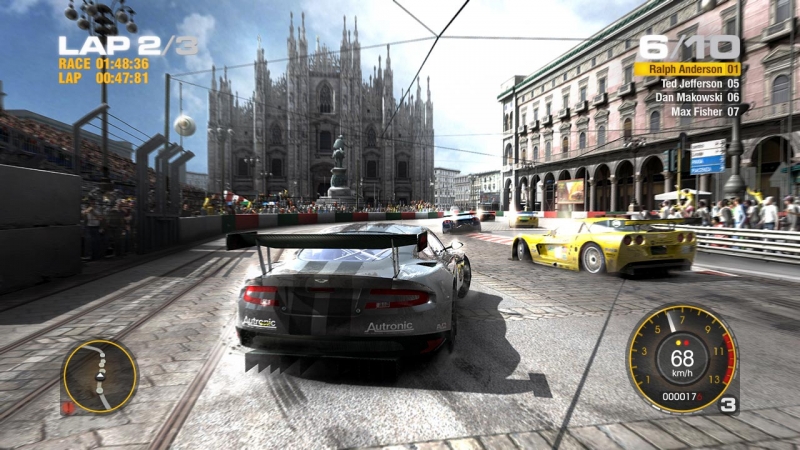
GRID’s main mode is a career mode called World Tour, where your aim is to become the highest ranking solo driver and racing team in the world. You start off by earning your rookie licence, but after that you’re free to compete in a wide selection of events that span several different racing types. As you progress through your career you unlock new events, new racing types and more cars to purchase. When your team is big enough you’re also able to gain plenty of sponsors, who give you funds in return for advertising on your vehicle, providing you meet certain minimum standards they expect from you (such as a podium finish or a 1st place finish). You’re also able to hire another driver, who will enter races alongside you as part of your team, earning you extra team points and giving you a cut of his earnings.
Career progression is similar to that found in DiRT. There are a number of event boxes that stack on top of each other and you're tasked with working your way from the bottom to the top. In GRID the events are split into three regions – Japan, Europe and America, with each region being home to different racing specialities (for example, Japan is home to a lot of drift races, America to muscle car races, and Europe to touring car races). You rack up points by winning events, those points then unlock more and more events. This allows you to avoid racing types you aren’t particularly keen on by making up the points in different events. It’s a system that worked well in DiRT and it continues to work well here.
There are five main racing types in GRID. First up are Drift events. Drift events come in a number of different forms. Drift GPs are tournaments where you compete against a single opponent for the highest score, Drift Battles are actual races where you compete for position and points, and Freestyle Drift events allow you to drift freely around an open area to rack up as many points as possible.
Secondly there are Touge races, which are head-to-head races along narrow Japanese mountain roads where you’re penalised for contact. These come in two different forms. Pro Touge races are daytime races where you race up and then down the track, with the person with the lowest overall time winning. If you touch the other car when overtaking a time penalty is added, which makes for some very challenging overtaking and tactical races. Midnight Touge races are similar to Pro Touge races, except they’re along open roads (i.e. there are civilian cars on the road) and take place at night.
Thirdly we have Demolition Derby races, which are pretty self-explanatory. These take place on small tracks with paths that cross over so that they’re ideal for large pile ups and aggressive driving. My one criticism of the Demolition Derby races is that there are only two Demolition Derby tracks and the game could really do with some more because they’re a fun aside to the main events, but with only two tracks there’s not much longevity there. Fourthly we have Endurance races which are typically reserved for the last race in each season. These are essentially 24 hour Le Mans races along a massive track, where each minute of gameplay represents one hour in the race. Cars in these races are divided into 4 classes and you compete against the cars that are in the same class as yours, so you don’t have to finish first overall, just first in your overall class.
Finally, there are standard races with muscle cars, open wheel (Formula 1-style vehicles) cars, touring cars, prototypes etc. You race against up to 20 AI-controlled cars from the same class as your car, on any of a number of different tracks from all over the world. The AI is superb, drivers will take defensive lines into corners if you’re moving into position to overtake, they fight aggressively for the racing line and have no qualms about ramming you back if you decide to try and take them out. This is isn’t just limited to your own interactions with them, they will also scrap amongst themselves for position regardless of where in the pack you are. One of my most memorable moments in the game was charging down a long straight about five seconds behind the main pack. There were three cars in the leading group that were neck and neck, vying for position, with a few others right behind them. Then suddenly one of those drivers made a colossal mistake under pressure and clipped the car next to him at an awkward angle, causing his car to flip up in the air with all four wheels off the ground. Spinning and twisting around in air, the car hurtled passed my own car as I swerved to narrowly avoid being taken out by him.
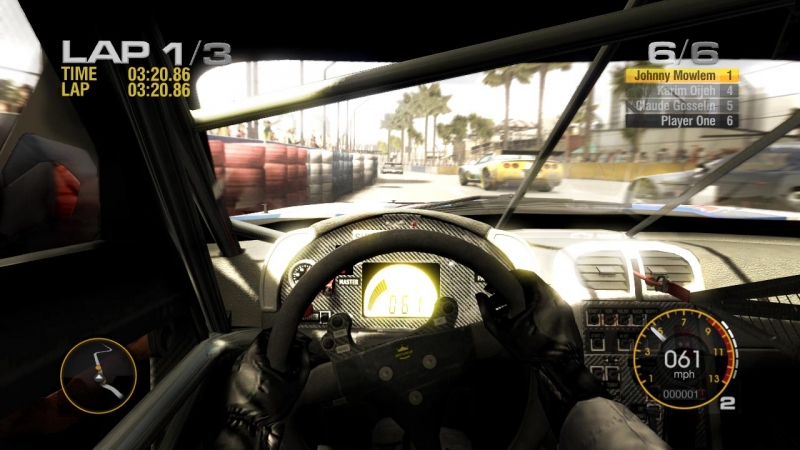
Moments like this in GRID are commonplace, each one is unique and distinct, with no two crashes being the same thanks to the game’s damage physics. They aren’t just scripted events that trigger at set intervals either, like the spinning out of AI controlled cars in Gran Turismo 5: Prologue for example. AI cars in GRID respond so uniquely to given situations that you could be forgiven for thinking that you’re actually racing against other players online. They don’t line up in single file and trundle around the track in a large convoy like they do in Forza and Gran Turismo games, they actually compete aggressively for position, make mistakes and cause pile-ups, crash out or suffer from crippling performance in high-speed accidents. All of these are unique events with genuine causes. The key point is that the AI cars have racing personalities and this elevates the game to a level of immersion and realism that is unusual in racing games.
The racing style is a great balance of simulation and arcade racing. The cars all look and feel realistic. The controls are tight and responsive, varying nicely from one racing discipline to another. Corners can be taken at speed without too much of a dip in speed, although breaking is required on the tighter corners. If the level of realism there is not to your liking all of the default assists relating to breaking, handling and difficulty can be turned off to provide a more realistic driving experience.
The gameplay is particularly addictive and engaging thanks to the genre-leading damage physics and modelling. Cars fall apart as the race progresses. Grazes with the barriers and nudges with competitors leave scratches and marks in the exact places contact was made. More serious crashes result in pieces of bodywork falling away, like the bumpers, bonnet, doors and windscreen. Involvement in a couple of medium impact collisions will usually result in reduced performance. Get caught up in a major pile-up and that will probably be the end of your race and you’ll get to see the crash in slow motion, unless you were lucky enough to come out of it in one piece that is. This isn’t just token damage modelling, it’s integral to GRID; it’s the best damage I’ve come across in a racing game and it’s an absolute joy to play around with and test to the limits.
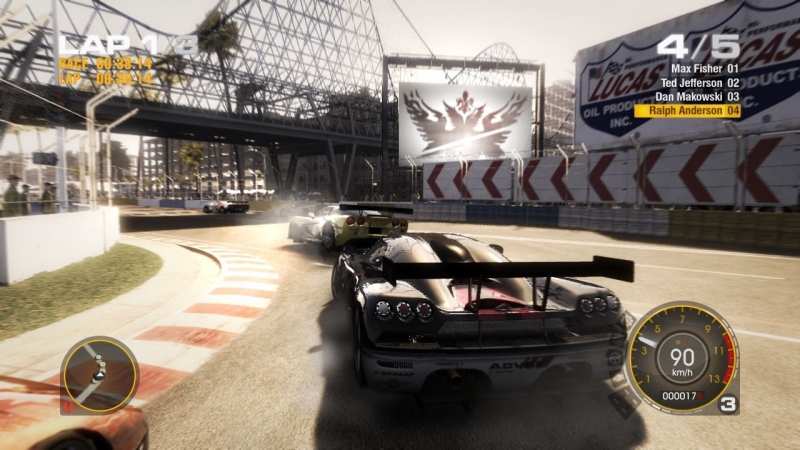
GRID also introduces a new flashback feature to work alongside these damage features. In each race you’re allotted a set number of flashbacks. The number you get depends on the difficulty you select and if you choose not to receive any flashbacks you are suitably rewarded at the end of each race. Each flashback can be used at any point in the race to rewind the last 10 seconds of the game, you can then pick any point within those 10 seconds to carry on racing. This means that if you’re involved a high impact crash which wrecks your car you can use the flashback feature to go back a few seconds prior to the crash and hopefully avoid the accident. Thanks to the smooth implementation of the flashback feature it makes an excellent addition to the game that really compliments the damage system.
The first thing you do when you start the game is create a profile, which among other things allows you to select a nickname. The list of names available to choose from is extensive, and the name you eventually choose will then be used by your team for all future communication with you, such as welcoming you back when you load up the game or congratulating you on a well-executed passing manoeuvre during a race. As in DiRT, the menu and loading screens are some of the best in the industry. The menus float in the air and swoosh in an out of view as you select them and the loading screens neatly display your lifetime statistics.
The graphics are stunning. There’s a clear leap from DiRT to GRID in terms of graphics, and you can see this right from the start. Car models are more detailed (including realistic in-car views), tracks are more varied and vibrant, the levels of lighting bloom have clearly been toned down so that there’s no longer a problem with tracks being too bright, and the damage modelling has clearly had a lot of work put into it to make it a much deeper and more convincing experience. I think it’s fair to say that Gran Turismo 5: Prologue currently leads the genre in terms of photorealistic graphics, and whilst GRID comes in a close second, it doesn’t threaten to take Prologue’s crown in this respect. But GRID more than makes up for this in other respects, not least in the superb damage modelling which makes it feel graphically more complete than Prologue.
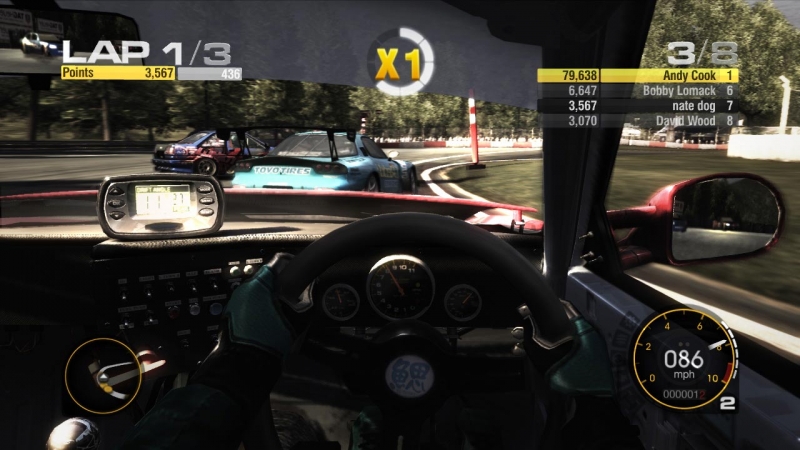
Tracks are well detailed and vibrant. Stands are full of active crowds. Places from all over the world are brilliantly re-created, from the grand architecture and tight street roads of the Italian tracks, to the winding roads of the Japanese mountain tracks where the sunlight filters through trees, leaving complex patterns of shadows on the track. Where the game really is ahead of the competition is in the field of damage modelling. Every little piece of every vehicle on the track can come away and then litter the track. Crashes are a genuine joy to watch, and the feel of the impact really hits home. It’s a core part of what makes GRID such an addictive racer. One technical issue that you may notice is some slowdown on the first corner if there’s a huge pile-up, but it’s not particularly obtrusive and it’s forgivable given the amount of carnage that takes place on the screen.
Engines roar appropriately and each car’s engine sound seems to fit it perfectly. Crowds cheer and scream on the starting line, and then when you come through the straights at speed you hear the satisfying sound of crowd noise zoom straight past your head. All aspects of the spectacular crash sequences are minutely detailed in GRID, and this carries on into the sound effects too, so you really get a feel for the violent crashes through the sound effects.
At the start of the review I detailed GRID’s World Tour mode, which acts as a career mode, but that’s just the key single player mode. On top of World Tour, the game includes a Test Drive mode, which kind of acts as GRID’s time trial mode. Here you can test out any of the cars you’ve bought in the World Tour mode and if you want to you can also download and race against leaderboard ghosts (and if you’re good enough you can submit your own times to the leaderboards). The final single player mode is called Race Day, which allows you to set up a single race to your own specific specifications – so you can tweak all of the usual racing options such as difficulty settings, assists, the specific track, number of laps, the cars, and so on. One thing that does hurt GRID’s value is the lack of splitscreen multiplayer, which isn’t something I look for in racers personally, but it’s become something of a staple for the genre and many will be disappointed by its absence.
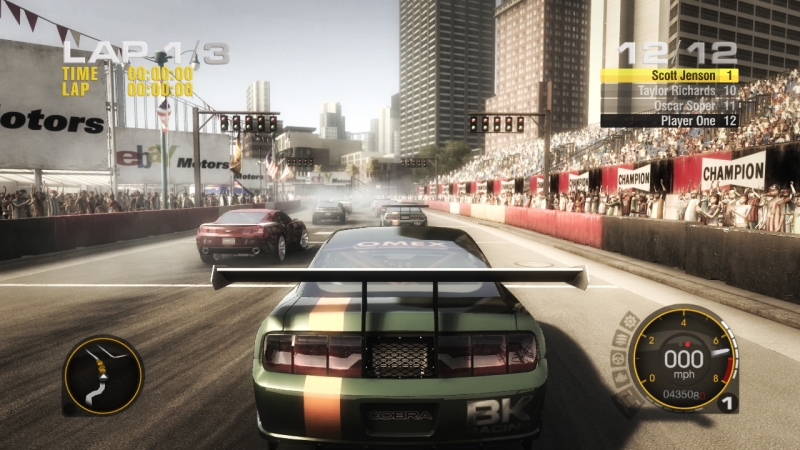
Finally there’s online multiplayer, which is another area of the game where GRID is well ahead of most of the competition. There’s support for up to 12 player races, and all of the racing types, tracks, cars and options found in the single player are available online, and even some that aren’t (such as being able to compete in matches where contact is not allowed). The gameplay and graphics are exactly as they are in the single player, so nothing is lost in the transition from offline single player to online multiplayer. Furthermore, the races are remarkably lag free, even with all of the activity that’s involved with 12 player races where damage is turned on.
The online interface is easy to use, and getting into a game is pretty quick. You select the sort of race you want to compete in to do a preliminary search and then pick a lobby from the results that the search throws up. In each of the lobbies something is always going on, which means that when you finish each race you go back to the lobby as a group, reputation points are dished out, voting commences on the next region and event you want to compete in, and then you race each other again straight away. If you join an existing lobby where everyone is still racing you can jump in and watch the action, the loading is really quick and you can flick from racer to racer with ease, so waiting for a race to finish is never too dull.
My favourite part of most races, particularly online, is the first corner. With 12 cars all heading into a tight bend you just know that there’s going to be a pile up at some point, and attempting to avoid that pile-up is a complete thrill. Smoke and grit will fill the screen, pieces of cars will fly all over the place so that doors, bumpers and bodywork are left to litter the track. A car or two might make it out unscathed. The chasing pack pick themselves up, jostle for position and hunt down the leaders. A few racers - the unlucky, wrecked few - will have their names pop up on the screen to signify that they’re out of the hunt. Or are they? They can choose to remove their cars from the track, but perhaps they feel like exacting a bit of revenge, in which case they can leave their car on the track to cause potential mayhem for the remaining racers come the second lap. That’s my inadequate attempt to put into words the thrill of racing online, where the level of unpredictability makes each single race truly unique. It’s a compelling and addictive experience.
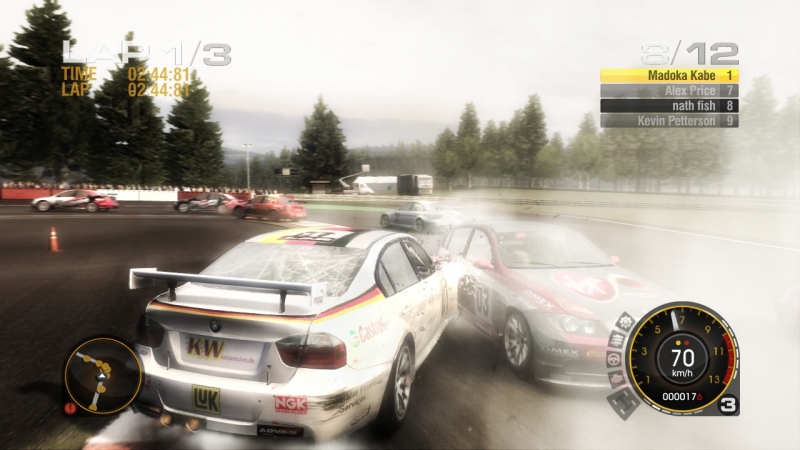
I can’t really praise GRID highly enough. Other than the omission of splitscreen multiplayer, GRID really is a superb and complete racing package. The graphics are excellent, made even more remarkable by the best damage modelling in racing to-date. The overall combination of damage modelling and physics makes for an addictive gameplay experience that truly varies from one race to the next, and it’s an experience which is made even more fantastic by the implementation of flawless online multiplayer. GRID is simply one of the best racers I have ever played.










| Total Sales |
0.01m
Japan |
0.33m
NA |
0.44m
Europe |
0.09m
Others |
0.87m
Total |
| 1 | n/a | n/a | 51,513 | 51,513 | |
| 2 | n/a | 31,845 | 33,129 | 11,013 | 75,987 |
| 3 | n/a | 21,503 | 21,556 | 7,304 | 50,363 |
| 4 | n/a | 16,943 | 16,016 | 5,597 | 38,556 |
| 5 | n/a | 13,903 | 9,766 | 4,043 | 27,712 |
| 6 | n/a | 10,038 | 6,666 | 2,856 | 19,560 |
| 7 | n/a | 9,197 | 6,868 | 2,741 | 18,806 |
| 8 | n/a | 10,375 | 6,337 | 2,863 | 19,575 |
| 9 | n/a | 8,871 | 5,773 | 2,505 | 17,149 |
| 10 | n/a | 7,269 | 5,503 | 2,179 | 14,951 |
|
|
|
|
|
|
|
|
BengaBenga
posted 27/01/2009, 10:52
Wow, this game is great. Best racer I played in years. Message | Report |
|
|
|
|
|
|
|
|
|